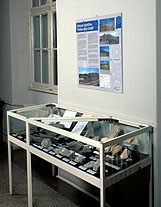The profile in the Middle Miocene rocks in the vicinity of Bela Cerkev was created during the construction of the Kronovo – Dobruška vas motorway section in the Dolenjska region. The profile covers (highly simplified) eight lithologically different and paleontologically interesting successive horizons, from A (lowest – oldest) to H (highest – youngest), with a thickness of about 30 meters:
A – The lowest part of the profile contains grey marls with numerous micro- and macrofauna of Badenian age, around 15 to 14 million years old, formed in the sea. Among the fossil remains, molluscs (bivalves and snails of the genera Anadara, Acanthocardia, Callista, Bucardium, Pecten, Pinna, Gastrana, Venus, Cytherea, Calyptraea and Turritella) seemingly prevail. The minute invisible skeletal remains of foraminifera and planktonic crustaceans and other microorganisms are represented by significantly greater numbers. The insolvable remains of the marl contain countless tiny skeletons of various organisms. In these rocks, no remains of aquatic mammals have been found.
Upwards, there follow about 13 to 12 million years old Sarmatian layers.
B – Few metres thick “oncolith-stromatolite” freshwater horizon. Here, carbonate mudstones, sands and conglomerates with individual oncoids, land snails and plant remains prevail. The most interesting are oncoids with a snail shell in the nucleus, which determines their shape. Shells of only one snail species, Brotia (Tinnyea) escheri, were identified in the cores.
C – Up to two metres thick “black brackish horizon”, containing dark grey to black laminated marls with charred plant remains, numerous snails of the genera Granulolabium, Terebralia and Ocinebrina, and rare shells of the genus Solen. Here and there, thinner coal lenses can also be found.
D – The easily noticeable few metres thick layers of calcareous yellowish-brown castorite clastites or the “yellow horizon”, consisting of sand, sandstone and conglomerates. In between, individual thinner and thicker sheets and lenses of very solid biocalcarenites occur. In some places, there are more plant remains, and more animal remains elsewhere. In yellow sandstones, numerous nests or accumulations of predominantly most diverse shells of brachyhale molluscs of the genera Calliostoma, Clithon, Hydrobia, Turboella, Bittium, Granulolabium, Terebralia, Natica, Ocinebrina, Cerithium, Retusa, Acteocina, Musculus, Mactra, Ervilia and Solen were found. The rocks of this horizon are also rich with remains of foraminifera, ostracods and other microorganisms. A tiny unidentifiable bone of a water mammal was found here as well.
E – About five metres thick bluish diatomaceous marl with bivalves, snails, fish remains and coprolites (excrements) of water mammals. Few dolphin bones were found in the upper part of this horizon, where plant remains occur occasionally as well.
F – An approximately five-metre large horizon with alternating laminated carbonate sandy siltstones and greenish-grey massive carbonate diatomaceous siltstones. In them, microfloristic and mollusc remains were found.
G – A few metres thick horizon of light grey massive non-carbonate and carbonate diatomaceous mudstone with bone remains of dolphins and their faeces, with remains of fish as well as impressions and bivalve shells predominantly of the genera Cerastoderma, Mactra and Ervilia.
H – The profile terminates with a few metre large horizon of light grey to yellowish laminated and foliated diatomaceous silt with bivalve remains, most often of the genus Cerastoderma. Numerous and beautiful remains of plants, prints and skeletons of fish, their scales, remains of dolphins and coprolites are also present here. In this horizon, two vertebrae of an adult dolphin were also recorded.
Geological monitoring of the construction of the motorway section, professional processing of paleontological finds, photos and text: Asst Prof Dr Vasja Mikuž, Department of Geology, Faculty of Natural Sciences and Engineering, University of Ljubljana.
Fossil dolphins of Slovenia
The Cenozoic is, inter alia, also the period of development and prosperity of mammals. In Slovenia, mammal fossil remains can be found in Tertiary and Quaternary rocks. Most remains of marine mammals – whales and dolphins – are from the Middle Miocene Badenian and Sarmatian 16 to 12 million years old deposits. Until recently, only two finds of Miocene dolphins had been recorded: the upper jawbone at Jesenice na Dolenjskem and part of the jawbone from Janeževa Gorca in the area of Bizeljsko.
In 2002 and 2003, a few different dolphin skeletal parts were discovered in the profile of Sarmatian rocks near Bela Cerkev in the Dolenjska region. Upon the taxidermic treatment of the bone remains, taxidermists identified parts of the skull and jaw, vertebrae, scapula, bones of the forelimb or fins and parts of the ribs. The skeletal remains belong to four or five adults and juveniles of the already extinct family Acrodelphidae, most probably the genera Acrodelphis or Champsodelphis?
The first and for the time being the only dolphin site in Slovenia, where a few different bone remains in situ have been found with a reliable lithological and stratigraphic classification, is located in the vicinity of Bela Cerkev. The finds are significant for taxonomic-systematic, paleoecological and paleogeographical studies within the Central Paratethys and for possible links with other sedimentary aquatic zones and bioprovinces of that time. Asst Prof Dr Vasja Mikuž



